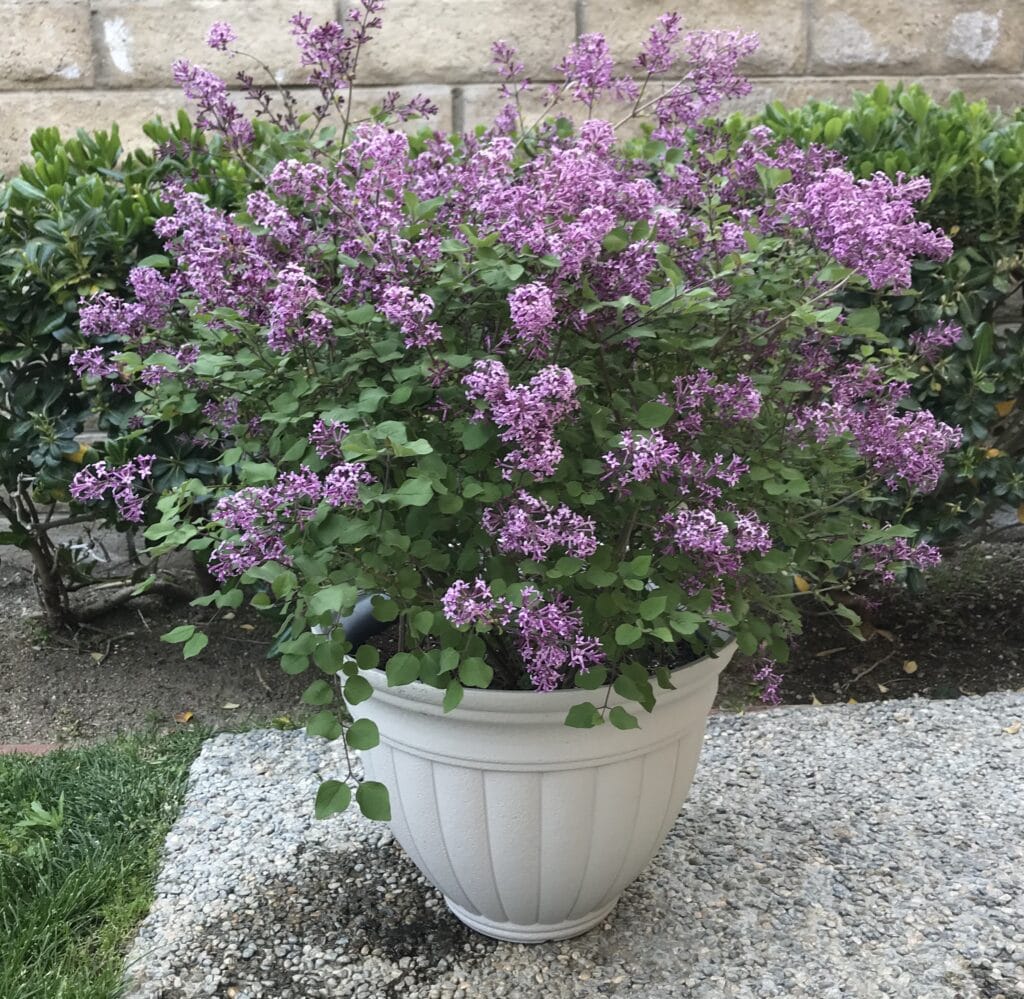Lilacs are classic spring-blooming shrubs known for their beautifully colored and fragrant flowers. Their large size and spreading habit make them ideal for planting in the landscape but what if you don’t have enough yard space? Can you grow lilacs in a pot?
Yes, you can grow lilacs in pots as long as you know how to take care of them and do it right. Lilacs do better in the ground, but if they are given the right conditions, they can do well in pots as well.
This detailed guide will tell you everything you need to know to grow lilacs successfully in pots, such as:
Choosing the Right Lilac Variety
-
Look for dwarf or compact varieties under 8 feet tall. Some good options: Dwarf Korean, Bloomerang, Miss Kim.
-
Larger varieties like common lilac can also work but will require bigger pots.
Using the Largest Pot Possible
-
Aim for a pot at least 2 feet wide and deep.
-
Lilacs have large root systems that need room to spread.
-
Bigger pots retain more moisture.
Providing Proper Drainage
-
Make sure pot has adequate drainage holes (at least 20% of surface area).
-
Add more holes if needed using a drill or screwdriver.
-
Avoid rocks or pot shards at bottom which can hinder drainage.
The Right Potting Mix
-
Use a mix of potting soil, garden soil, and compost.
-
Lilacs prefer neutral to alkaline soil, pH of 6.5-7.0.
-
Add lime if needed to decrease acidity.
Planting at the Correct Depth
-
Plant crown slightly above soil level to prevent rot.
-
Backfill soil around root ball, keeping it just below crown.
Full Sun Exposure
-
Lilacs need at least 6 hours of direct sunlight per day.
-
More sun = more blooms.
Consistent Watering
-
Check soil daily, water when top 1″ is dry.
-
Soak at roots, avoid wetting foliage.
Using Organic Mulch
-
Mulch helps retain moisture between waterings.
-
Keep mulch 6″ away from trunks and stems.
Early Spring Fertilizing
-
Use granular fertilizer with a ratio like 5-10-10.
-
Focus on phosphorus and potassium to encourage blooms.
Deadheading Spent Flowers
- Prune off faded blooms above leaf set to encourage reblooming.
Annual Pruning
-
Prune right after flowering finishes.
-
Remove 1/3 of branches, deadwood, suckers annually.
-
Cut back tall canes, shape rounded form.
Protecting in Winter
-
Lilacs are cold hardy but shield from wind.
-
Avoid bringing indoors.
Lilacs in pots can grow well and produce their beautiful, fragrant flowers even in small spaces if they get the right care. Make sure to pick varieties that are compact, use big containers, give them plenty of sunlight and drainage, fertilize them correctly, and prune them as needed. Lilacs grown in containers need to be carefully watered and watched, but the spring flowers they produce are well worth the work.

Add a Layer of Mulch
Add a layer of organic mulch to keep moisture in the pot.
Put some organic mulch around the base of your potted lilac to keep it from drying out between waterings. Wood chips, pine bark, sawdust, hay, leaves, or a layer of compost all work well in pots.
Be careful not to pile any materials up to around your lilac’s trunk or stems, keeping a 6-inch radius completely mulch-free. This will discourage issues with rot and pests.
Place Your Container in The Sun
Although lilacs can grow in shade, they need at least 6 hours of sunlight.
Lilacs need at least six hours of sun a day, but many cultivars can do well in very sunny places. They will benefit from a location that is hot in the afternoon. While they will survive in a slightly shady spot, they will not flower well or grow as quickly. They will also be more vulnerable to shade-related conditions such as powdery mildew.
Watering lilacs depends on the size of the pot and should be focused on the roots of the lilacs.
The size of your pot will determine how often your potted lilac needs to be watered. A larger volume of soil will hold water longer, and you might be able to go a few days between watering. But a smaller ratio of roots to dirt means you should check them every day, or at least every other day.
Watering should be concentrated at your lilac’s roots and not its leaves, as they are prone to fungal conditions. Use a watering can or shower setting on your hose nozzle to soak but not drench the dirt surrounding the plant.
Continue watering into fall, but stop when lilac loses its leaves and enters dormancy. Begin watering again next season when soil has thawed in early spring.
Planting Lilacs in Containers! Everything you need to know. I love this Shrub! //FlowerFanatic
FAQ
Do lilacs do well in pots?
Smaller lilac plants, such as our Bloomerang® Dwarf Pink Lilac, can thrive in containers. Appropriate care of potted lilac plants is important. Place it in a south facing window that receives at least 6 hours of full sun every day.
What is the Old Wives tale about lilacs?
Sadly lilacs have become associated with bad omens and many believe that bringing lilacs into the house will bring bad luck and possibly death to the …Apr 25, 2014.
How many years does it take for a lilac tree to bloom?
*Age: Lilac plants need time to grow before they begin flowering. So, if you have a very young plant, it may not be mature enough to bloom. Most plants start blooming after three or four years but some may take as long as six or seven. The blooms for the first few years will be sparse but should increase with time.
Where should you not plant lilac bushes?
Lilac bushes bloom best in full sun, which is at least 6 hours of direct sunlight per day. Too much shade will result in fewer blooms and increased risk of fungal diseases.
